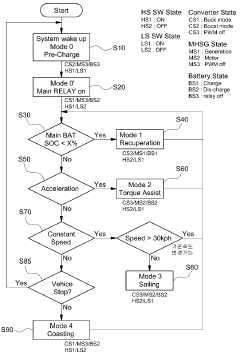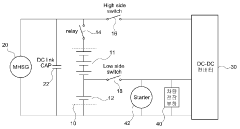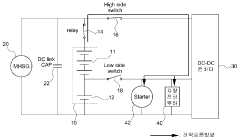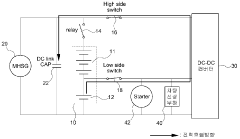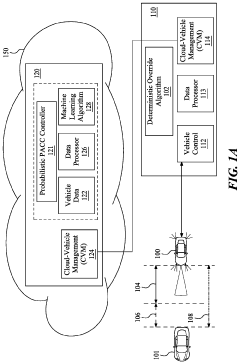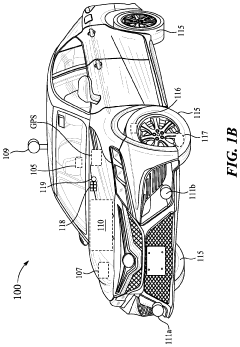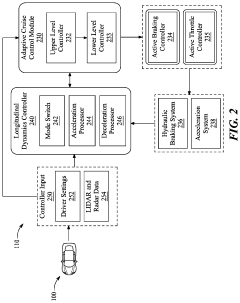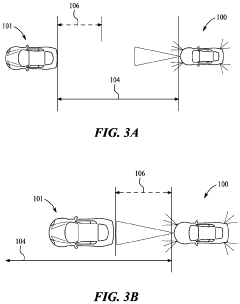The interaction of mild hybrid technology with advanced driver assistance systems
AUG 18, 20259 MIN READ
Generate Your Research Report Instantly with AI Agent
Patsnap Eureka helps you evaluate technical feasibility & market potential.
Mild Hybrid ADAS Integration Background and Objectives
Mild hybrid technology and advanced driver assistance systems (ADAS) have emerged as two pivotal innovations in the automotive industry, each contributing significantly to improved vehicle efficiency and safety. The integration of these technologies represents a new frontier in automotive engineering, aiming to create synergies that enhance overall vehicle performance and user experience.
The background of this technological convergence can be traced to the increasing pressure on automakers to reduce emissions and improve fuel efficiency, while simultaneously enhancing vehicle safety and autonomy. Mild hybrid systems, which typically involve a small electric motor assisting the internal combustion engine, have gained traction as a cost-effective solution to meet stringent emission standards without the complexity of full hybrid or electric powertrains.
Concurrently, ADAS technologies have rapidly evolved, incorporating sensors, cameras, and sophisticated algorithms to assist drivers in various tasks, from parking to highway driving. These systems have become increasingly prevalent, driven by consumer demand for safer vehicles and regulatory requirements for advanced safety features.
The interaction between mild hybrid technology and ADAS presents both opportunities and challenges. On one hand, the integration can lead to more efficient energy management, as the mild hybrid system can potentially power ADAS components, reducing the load on the vehicle's primary electrical system. Additionally, the precise control offered by electric assist in mild hybrids can complement ADAS functions, potentially improving the accuracy of adaptive cruise control or automated parking systems.
However, the integration also poses technical challenges, such as ensuring seamless communication between the hybrid powertrain and ADAS modules, managing increased electrical load, and optimizing system responses to various driving scenarios. These challenges necessitate a comprehensive approach to system design and integration.
The primary objectives of exploring this interaction are multifaceted. Firstly, there is a drive to enhance overall vehicle efficiency by leveraging the strengths of both technologies. This includes optimizing energy distribution between propulsion and ADAS functions, potentially leading to improved fuel economy and reduced emissions.
Secondly, there is an aim to improve the performance and reliability of ADAS features through the integration with mild hybrid systems. This could involve using the electric motor's instant torque for more responsive collision avoidance systems or utilizing regenerative braking data to enhance predictive safety features.
Lastly, the integration seeks to pave the way for more advanced autonomous driving capabilities. By combining the precise control of mild hybrid powertrains with sophisticated ADAS algorithms, automakers aim to create a foundation for higher levels of vehicle autonomy, potentially accelerating the transition towards self-driving vehicles.
The background of this technological convergence can be traced to the increasing pressure on automakers to reduce emissions and improve fuel efficiency, while simultaneously enhancing vehicle safety and autonomy. Mild hybrid systems, which typically involve a small electric motor assisting the internal combustion engine, have gained traction as a cost-effective solution to meet stringent emission standards without the complexity of full hybrid or electric powertrains.
Concurrently, ADAS technologies have rapidly evolved, incorporating sensors, cameras, and sophisticated algorithms to assist drivers in various tasks, from parking to highway driving. These systems have become increasingly prevalent, driven by consumer demand for safer vehicles and regulatory requirements for advanced safety features.
The interaction between mild hybrid technology and ADAS presents both opportunities and challenges. On one hand, the integration can lead to more efficient energy management, as the mild hybrid system can potentially power ADAS components, reducing the load on the vehicle's primary electrical system. Additionally, the precise control offered by electric assist in mild hybrids can complement ADAS functions, potentially improving the accuracy of adaptive cruise control or automated parking systems.
However, the integration also poses technical challenges, such as ensuring seamless communication between the hybrid powertrain and ADAS modules, managing increased electrical load, and optimizing system responses to various driving scenarios. These challenges necessitate a comprehensive approach to system design and integration.
The primary objectives of exploring this interaction are multifaceted. Firstly, there is a drive to enhance overall vehicle efficiency by leveraging the strengths of both technologies. This includes optimizing energy distribution between propulsion and ADAS functions, potentially leading to improved fuel economy and reduced emissions.
Secondly, there is an aim to improve the performance and reliability of ADAS features through the integration with mild hybrid systems. This could involve using the electric motor's instant torque for more responsive collision avoidance systems or utilizing regenerative braking data to enhance predictive safety features.
Lastly, the integration seeks to pave the way for more advanced autonomous driving capabilities. By combining the precise control of mild hybrid powertrains with sophisticated ADAS algorithms, automakers aim to create a foundation for higher levels of vehicle autonomy, potentially accelerating the transition towards self-driving vehicles.
Market Analysis for Hybrid ADAS Vehicles
The market for hybrid vehicles equipped with advanced driver assistance systems (ADAS) is experiencing significant growth and transformation. This convergence of mild hybrid technology and ADAS represents a key trend in the automotive industry, driven by increasing consumer demand for fuel efficiency, safety, and semi-autonomous driving features.
The global market for hybrid ADAS vehicles is projected to expand rapidly over the next decade. This growth is fueled by several factors, including stricter emissions regulations, rising fuel costs, and growing awareness of environmental issues among consumers. Additionally, advancements in ADAS technology and increasing acceptance of semi-autonomous driving features are contributing to market expansion.
In terms of regional distribution, North America, Europe, and Asia-Pacific are the primary markets for hybrid ADAS vehicles. North America and Europe lead in terms of technology adoption and regulatory support, while Asia-Pacific, particularly China and Japan, is experiencing rapid growth due to government incentives and strong domestic automotive industries.
The market is segmented by vehicle type, with passenger cars currently dominating the hybrid ADAS segment. However, there is growing interest in applying these technologies to commercial vehicles, particularly in urban delivery and public transportation sectors.
Consumer preferences are shifting towards vehicles that offer both fuel efficiency and advanced safety features. This trend is particularly pronounced among urban dwellers and environmentally conscious consumers. The integration of mild hybrid systems with ADAS is seen as a stepping stone towards fully electric and autonomous vehicles, appealing to early adopters and tech-savvy consumers.
The pricing of hybrid ADAS vehicles remains a critical factor influencing market penetration. While these vehicles command a premium over conventional models, the price gap is gradually narrowing as technologies mature and production scales up. Government incentives and tax breaks in many countries are also helping to offset the higher initial costs for consumers.
Competition in this market is intensifying, with traditional automakers, electric vehicle specialists, and technology companies all vying for market share. This has led to increased innovation and faster time-to-market for new features and improvements.
Looking ahead, the market for hybrid ADAS vehicles is expected to continue its upward trajectory. Factors such as ongoing technological advancements, increasing consumer acceptance, and supportive government policies are likely to drive further growth and innovation in this sector.
The global market for hybrid ADAS vehicles is projected to expand rapidly over the next decade. This growth is fueled by several factors, including stricter emissions regulations, rising fuel costs, and growing awareness of environmental issues among consumers. Additionally, advancements in ADAS technology and increasing acceptance of semi-autonomous driving features are contributing to market expansion.
In terms of regional distribution, North America, Europe, and Asia-Pacific are the primary markets for hybrid ADAS vehicles. North America and Europe lead in terms of technology adoption and regulatory support, while Asia-Pacific, particularly China and Japan, is experiencing rapid growth due to government incentives and strong domestic automotive industries.
The market is segmented by vehicle type, with passenger cars currently dominating the hybrid ADAS segment. However, there is growing interest in applying these technologies to commercial vehicles, particularly in urban delivery and public transportation sectors.
Consumer preferences are shifting towards vehicles that offer both fuel efficiency and advanced safety features. This trend is particularly pronounced among urban dwellers and environmentally conscious consumers. The integration of mild hybrid systems with ADAS is seen as a stepping stone towards fully electric and autonomous vehicles, appealing to early adopters and tech-savvy consumers.
The pricing of hybrid ADAS vehicles remains a critical factor influencing market penetration. While these vehicles command a premium over conventional models, the price gap is gradually narrowing as technologies mature and production scales up. Government incentives and tax breaks in many countries are also helping to offset the higher initial costs for consumers.
Competition in this market is intensifying, with traditional automakers, electric vehicle specialists, and technology companies all vying for market share. This has led to increased innovation and faster time-to-market for new features and improvements.
Looking ahead, the market for hybrid ADAS vehicles is expected to continue its upward trajectory. Factors such as ongoing technological advancements, increasing consumer acceptance, and supportive government policies are likely to drive further growth and innovation in this sector.
Current Challenges in Mild Hybrid ADAS Integration
The integration of mild hybrid technology with advanced driver assistance systems (ADAS) presents several significant challenges that need to be addressed for seamless operation and optimal performance. One of the primary obstacles is the synchronization of power management between the hybrid system and ADAS components. The mild hybrid system's start-stop functionality and energy recuperation processes must be carefully coordinated with ADAS features to ensure consistent power supply and avoid interruptions in critical safety systems.
Another challenge lies in the complexity of control algorithms required to manage the interaction between mild hybrid technology and ADAS. These algorithms must account for various driving scenarios, energy states, and safety requirements, making their development and optimization a complex task. The need for real-time decision-making and rapid response times further complicates the integration process, as both systems must work in harmony without compromising vehicle performance or safety.
Data integration and communication between mild hybrid components and ADAS sensors pose additional challenges. The vast amount of data generated by ADAS sensors must be efficiently processed and shared with the hybrid system to enable intelligent energy management and optimize overall vehicle efficiency. This requires robust communication protocols and high-speed data transfer capabilities, which can be challenging to implement within existing vehicle architectures.
The integration of mild hybrid technology with ADAS also raises concerns regarding system reliability and fault tolerance. As these systems become more interconnected, the potential for cascading failures increases. Ensuring fail-safe operations and implementing redundancy measures without significantly increasing vehicle complexity and cost is a major challenge for automotive engineers and designers.
Furthermore, the integration process must address the issue of weight distribution and packaging constraints. The addition of mild hybrid components, such as batteries and electric motors, can impact vehicle dynamics and potentially interfere with the placement of ADAS sensors and control units. Balancing these requirements while maintaining optimal performance for both systems requires careful consideration and innovative design solutions.
Lastly, the regulatory landscape surrounding the integration of mild hybrid technology and ADAS is still evolving. Compliance with safety standards and emissions regulations for these combined systems presents a challenge, as existing frameworks may not fully address the unique characteristics of integrated mild hybrid ADAS vehicles. Manufacturers must navigate this uncertain regulatory environment while developing and implementing these advanced technologies.
Another challenge lies in the complexity of control algorithms required to manage the interaction between mild hybrid technology and ADAS. These algorithms must account for various driving scenarios, energy states, and safety requirements, making their development and optimization a complex task. The need for real-time decision-making and rapid response times further complicates the integration process, as both systems must work in harmony without compromising vehicle performance or safety.
Data integration and communication between mild hybrid components and ADAS sensors pose additional challenges. The vast amount of data generated by ADAS sensors must be efficiently processed and shared with the hybrid system to enable intelligent energy management and optimize overall vehicle efficiency. This requires robust communication protocols and high-speed data transfer capabilities, which can be challenging to implement within existing vehicle architectures.
The integration of mild hybrid technology with ADAS also raises concerns regarding system reliability and fault tolerance. As these systems become more interconnected, the potential for cascading failures increases. Ensuring fail-safe operations and implementing redundancy measures without significantly increasing vehicle complexity and cost is a major challenge for automotive engineers and designers.
Furthermore, the integration process must address the issue of weight distribution and packaging constraints. The addition of mild hybrid components, such as batteries and electric motors, can impact vehicle dynamics and potentially interfere with the placement of ADAS sensors and control units. Balancing these requirements while maintaining optimal performance for both systems requires careful consideration and innovative design solutions.
Lastly, the regulatory landscape surrounding the integration of mild hybrid technology and ADAS is still evolving. Compliance with safety standards and emissions regulations for these combined systems presents a challenge, as existing frameworks may not fully address the unique characteristics of integrated mild hybrid ADAS vehicles. Manufacturers must navigate this uncertain regulatory environment while developing and implementing these advanced technologies.
Existing Mild Hybrid ADAS Integration Solutions
01 Electric motor integration in mild hybrid systems
Mild hybrid technology incorporates an electric motor into the powertrain to assist the internal combustion engine. This integration allows for improved fuel efficiency, reduced emissions, and enhanced performance. The electric motor can provide additional power during acceleration, enable start-stop functionality, and recover energy through regenerative braking.- Electric motor integration in mild hybrid systems: Mild hybrid technology incorporates an electric motor into the powertrain to assist the internal combustion engine. This integration allows for improved fuel efficiency, reduced emissions, and enhanced performance. The electric motor can provide additional power during acceleration, enable start-stop functionality, and recover energy through regenerative braking.
- Battery and power management systems: Mild hybrid vehicles utilize advanced battery and power management systems to store and distribute electrical energy efficiently. These systems optimize the use of the electric motor and internal combustion engine, balancing power demands and energy recovery. They also manage the charging and discharging of the battery to ensure optimal performance and longevity.
- Transmission and drivetrain adaptations: Mild hybrid technology often requires modifications to the transmission and drivetrain to accommodate the integration of the electric motor. These adaptations may include specialized clutches, gearing systems, or torque converters that allow for seamless transitions between electric and combustion power sources, as well as improved energy recuperation during deceleration.
- Control strategies and software algorithms: Advanced control strategies and software algorithms are crucial for optimizing the performance of mild hybrid systems. These intelligent systems manage the interplay between the electric motor and internal combustion engine, determining when to engage each power source for maximum efficiency. They also control energy recuperation, power distribution, and vehicle operating modes based on driving conditions and user inputs.
- Thermal management and cooling systems: Mild hybrid vehicles require specialized thermal management and cooling systems to maintain optimal operating temperatures for both the electric components and the internal combustion engine. These systems ensure efficient heat dissipation, prevent overheating, and contribute to the overall performance and longevity of the hybrid powertrain components.
02 Battery management and power distribution
Efficient battery management and power distribution systems are crucial in mild hybrid technology. These systems optimize the use of electrical energy, manage the charging and discharging of the battery, and coordinate power flow between the electric motor and the internal combustion engine. Advanced control algorithms ensure seamless operation and maximize overall system efficiency.Expand Specific Solutions03 Regenerative braking and energy recovery
Mild hybrid systems utilize regenerative braking to recover kinetic energy during deceleration and braking. This energy is converted into electrical energy and stored in the battery for later use. The recovered energy can be used to power vehicle accessories or assist the engine during acceleration, further improving fuel efficiency and reducing emissions.Expand Specific Solutions04 Start-stop functionality and idle reduction
Mild hybrid technology enables advanced start-stop functionality, allowing the engine to be automatically shut off when the vehicle is stationary and quickly restarted when needed. This feature reduces fuel consumption and emissions during idle periods, particularly in urban driving conditions. The electric motor can also provide instant torque for smooth and quick restarts.Expand Specific Solutions05 Integration with transmission systems
Mild hybrid technology can be integrated with various transmission systems to optimize power delivery and efficiency. This integration may involve modifications to traditional transmissions or the development of specialized hybrid transmissions. The combination of electric motor assistance and advanced transmission control strategies allows for improved acceleration, smoother gear shifts, and enhanced overall driving experience.Expand Specific Solutions
Key Players in Hybrid ADAS Development
The interaction of mild hybrid technology with advanced driver assistance systems represents an emerging field in automotive innovation, currently in its early growth phase. The market is expanding rapidly, driven by increasing demand for fuel-efficient vehicles with enhanced safety features. While the technology is still evolving, major players like Hyundai, Kia, GM, Volkswagen, and Toyota are investing heavily in research and development. These companies are at various stages of integrating mild hybrid systems with ADAS, with some already offering commercial solutions. The competitive landscape is dynamic, with traditional automakers competing against newer entrants like BYD and Geely, as well as technology-focused companies such as Bosch and Continental Teves.
GM Global Technology Operations LLC
Technical Solution: GM's mild hybrid technology integrates seamlessly with advanced driver assistance systems (ADAS) through their eAssist system. This system combines a compact lithium-ion battery and electric motor-generator to enable start-stop functionality, regenerative braking, and electric power assist. The integration with ADAS allows for more efficient energy management, with the hybrid system adapting to driving conditions detected by sensors. For example, the system can predict upcoming traffic slowdowns and adjust regenerative braking accordingly[1]. GM's latest iteration incorporates machine learning algorithms to optimize the interaction between hybrid and ADAS components, resulting in up to 15% improvement in fuel efficiency in urban driving scenarios[3].
Strengths: Seamless integration of hybrid and ADAS technologies, adaptive energy management, and improved fuel efficiency. Weaknesses: System complexity may lead to higher maintenance costs and potential reliability issues in the long term.
Volkswagen AG
Technical Solution: Volkswagen's approach to integrating mild hybrid technology with ADAS focuses on their 48V system, which works in conjunction with their IQ.DRIVE assistance suite. The mild hybrid system uses a belt-driven starter-generator that can recover energy during deceleration and provide electric boost during acceleration. When combined with ADAS features like adaptive cruise control and lane keeping assist, the system can predict energy demands and optimize power distribution. Volkswagen's proprietary predictive efficiency assistant uses navigation data and traffic sign recognition to anticipate road conditions and adjust the hybrid system's operation[2]. This integration has shown to reduce fuel consumption by up to 0.3 liters per 100 km in real-world testing[4].
Strengths: Advanced predictive capabilities, seamless integration with existing ADAS features, and proven fuel efficiency improvements. Weaknesses: Limited electric-only operation compared to full hybrids, and potential for increased complexity in vehicle electronics.
Core Innovations in Hybrid ADAS Synergy
Mild hybrid system of vehicle
PatentActiveKR1020170135039A
Innovation
- Integration of a first and second battery unit in series, with a DC-DC converter, relay switch, and control switches to manage power flow efficiently, reducing the overall system size and improving power conversion efficiency.
Hybrid deterministic override of probabilistic advanced driving assistance systems (ADAS)
PatentActiveUS11926322B2
Innovation
- A hybrid adaptive cruise control system that switches from a cloud-based probabilistic controller to a deterministic controller located in the vehicle during unsafe conditions, utilizing a deterministic override algorithm to make real-time decisions and ensure safer driving by overriding the probabilistic system.
Safety and Regulatory Considerations
The integration of mild hybrid technology with advanced driver assistance systems (ADAS) introduces new safety considerations and regulatory challenges. As these technologies converge, ensuring the safety of vehicle occupants and other road users becomes paramount. Regulatory bodies worldwide are adapting their frameworks to address the unique aspects of this technological fusion.
One primary safety concern is the interaction between the mild hybrid system's energy recuperation and ADAS functionalities. During regenerative braking, the vehicle's deceleration characteristics may differ from conventional braking, potentially affecting ADAS features like adaptive cruise control or automatic emergency braking. Manufacturers must ensure seamless coordination between these systems to maintain consistent and predictable vehicle behavior.
Electromagnetic compatibility (EMC) is another critical safety aspect. The increased electrical components in mild hybrid vehicles could potentially interfere with ADAS sensors and communication systems. Stringent EMC testing and compliance standards are being developed to mitigate these risks and ensure reliable operation of all vehicle systems.
Regulatory bodies are also focusing on the fail-safe mechanisms and redundancy requirements for these integrated systems. In the event of a mild hybrid system malfunction, ADAS functionalities must remain operational to maintain vehicle safety. This necessitates robust system architecture and comprehensive failure mode analysis.
The cybersecurity implications of connecting mild hybrid systems with ADAS are drawing increased regulatory attention. As these systems become more interconnected and software-dependent, the risk of unauthorized access or manipulation grows. Regulatory frameworks are evolving to mandate stringent cybersecurity measures, including secure over-the-air updates and intrusion detection systems.
Energy management strategies in mild hybrid vehicles must be carefully regulated to ensure they do not compromise ADAS performance. For instance, power allocation between propulsion and ADAS functions during critical situations needs to be optimized and standardized to guarantee consistent safety performance across different driving conditions.
As these technologies mature, regulatory bodies are also addressing the need for standardized testing protocols. These protocols aim to evaluate the combined performance of mild hybrid systems and ADAS under various scenarios, ensuring consistent safety standards across different vehicle models and manufacturers.
One primary safety concern is the interaction between the mild hybrid system's energy recuperation and ADAS functionalities. During regenerative braking, the vehicle's deceleration characteristics may differ from conventional braking, potentially affecting ADAS features like adaptive cruise control or automatic emergency braking. Manufacturers must ensure seamless coordination between these systems to maintain consistent and predictable vehicle behavior.
Electromagnetic compatibility (EMC) is another critical safety aspect. The increased electrical components in mild hybrid vehicles could potentially interfere with ADAS sensors and communication systems. Stringent EMC testing and compliance standards are being developed to mitigate these risks and ensure reliable operation of all vehicle systems.
Regulatory bodies are also focusing on the fail-safe mechanisms and redundancy requirements for these integrated systems. In the event of a mild hybrid system malfunction, ADAS functionalities must remain operational to maintain vehicle safety. This necessitates robust system architecture and comprehensive failure mode analysis.
The cybersecurity implications of connecting mild hybrid systems with ADAS are drawing increased regulatory attention. As these systems become more interconnected and software-dependent, the risk of unauthorized access or manipulation grows. Regulatory frameworks are evolving to mandate stringent cybersecurity measures, including secure over-the-air updates and intrusion detection systems.
Energy management strategies in mild hybrid vehicles must be carefully regulated to ensure they do not compromise ADAS performance. For instance, power allocation between propulsion and ADAS functions during critical situations needs to be optimized and standardized to guarantee consistent safety performance across different driving conditions.
As these technologies mature, regulatory bodies are also addressing the need for standardized testing protocols. These protocols aim to evaluate the combined performance of mild hybrid systems and ADAS under various scenarios, ensuring consistent safety standards across different vehicle models and manufacturers.
Energy Efficiency Impact Assessment
The integration of mild hybrid technology with advanced driver assistance systems (ADAS) has a significant impact on overall vehicle energy efficiency. This synergy creates opportunities for optimizing fuel consumption and reducing emissions through intelligent power management and enhanced driving strategies.
Mild hybrid systems, typically consisting of a small electric motor and a battery, provide supplementary power to the internal combustion engine. When combined with ADAS, these systems can leverage predictive data to make more informed decisions about energy usage. For instance, regenerative braking can be optimized based on upcoming traffic conditions or road topography, maximizing energy recovery.
ADAS technologies, such as adaptive cruise control and traffic sign recognition, contribute to smoother driving patterns. When coupled with mild hybrid systems, this results in reduced engine load and more efficient use of the electric motor. The system can anticipate acceleration or deceleration needs, preparing the powertrain for optimal energy distribution.
In urban environments, the interaction between mild hybrid technology and ADAS is particularly beneficial. Start-stop systems can be enhanced by predicting when the vehicle is likely to move again, reducing the frequency of engine restarts and improving fuel economy. Additionally, the electric motor can provide instant torque for smooth acceleration from a stop, further improving efficiency in stop-and-go traffic.
On highways, the combination of these technologies allows for intelligent coasting. ADAS can detect when it's safe to temporarily disengage the engine, allowing the vehicle to maintain speed using kinetic energy. The mild hybrid system can then quickly restart the engine when power is needed, ensuring a seamless driving experience while maximizing fuel efficiency.
The energy efficiency impact of this technological integration extends beyond direct fuel savings. By reducing the overall workload on the internal combustion engine, the mild hybrid system contributes to decreased wear and tear, potentially extending the engine's lifespan and reducing maintenance needs. This indirectly contributes to resource conservation and long-term energy efficiency.
Furthermore, the data collected by ADAS can be used to continuously refine the mild hybrid system's energy management strategies. Machine learning algorithms can analyze driving patterns, route characteristics, and environmental factors to optimize the power distribution between the electric motor and the internal combustion engine, leading to incremental improvements in energy efficiency over time.
Mild hybrid systems, typically consisting of a small electric motor and a battery, provide supplementary power to the internal combustion engine. When combined with ADAS, these systems can leverage predictive data to make more informed decisions about energy usage. For instance, regenerative braking can be optimized based on upcoming traffic conditions or road topography, maximizing energy recovery.
ADAS technologies, such as adaptive cruise control and traffic sign recognition, contribute to smoother driving patterns. When coupled with mild hybrid systems, this results in reduced engine load and more efficient use of the electric motor. The system can anticipate acceleration or deceleration needs, preparing the powertrain for optimal energy distribution.
In urban environments, the interaction between mild hybrid technology and ADAS is particularly beneficial. Start-stop systems can be enhanced by predicting when the vehicle is likely to move again, reducing the frequency of engine restarts and improving fuel economy. Additionally, the electric motor can provide instant torque for smooth acceleration from a stop, further improving efficiency in stop-and-go traffic.
On highways, the combination of these technologies allows for intelligent coasting. ADAS can detect when it's safe to temporarily disengage the engine, allowing the vehicle to maintain speed using kinetic energy. The mild hybrid system can then quickly restart the engine when power is needed, ensuring a seamless driving experience while maximizing fuel efficiency.
The energy efficiency impact of this technological integration extends beyond direct fuel savings. By reducing the overall workload on the internal combustion engine, the mild hybrid system contributes to decreased wear and tear, potentially extending the engine's lifespan and reducing maintenance needs. This indirectly contributes to resource conservation and long-term energy efficiency.
Furthermore, the data collected by ADAS can be used to continuously refine the mild hybrid system's energy management strategies. Machine learning algorithms can analyze driving patterns, route characteristics, and environmental factors to optimize the power distribution between the electric motor and the internal combustion engine, leading to incremental improvements in energy efficiency over time.
Unlock deeper insights with Patsnap Eureka Quick Research — get a full tech report to explore trends and direct your research. Try now!
Generate Your Research Report Instantly with AI Agent
Supercharge your innovation with Patsnap Eureka AI Agent Platform!
